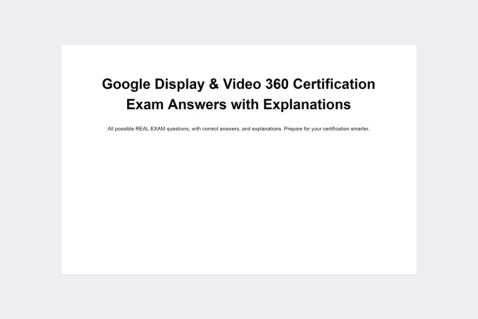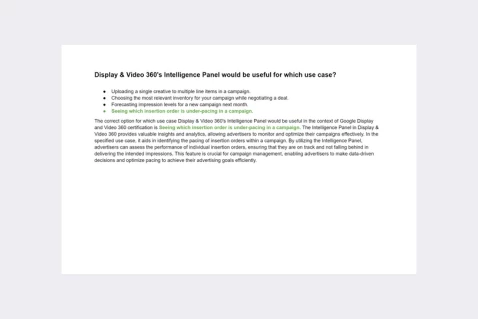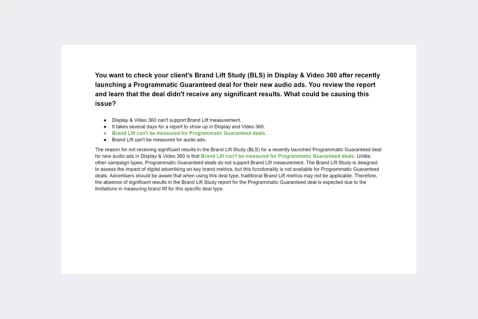Your new colleague is trying to learn more about the options for customizing attribution models in Display & Video 360. How would you accurately summarize those options?
You can use view-through conversions (VTCs) to give twice as much attribution credit to viewable impressions.
You can only enable viewable view-through conversions (VTCs) on a last interaction attribution model.
You can use conversion modeling to help fill the gap when some conversions can't be observed and attributed directly.
You can't enable conversion modeling and viewable view-through conversions (VTCs) on the same attribution model.
Certification program: 👉 Google Display and Video 360 certification exam
Explanation: You can use conversion modeling to help fill the gap when some conversions can’t be observed and attributed directly. In Display & Video 360, the option to customize attribution models involves utilizing conversion modeling to address situations where direct observation and attribution of conversions are not possible. Conversion modeling allows advertisers to account for conversions that may not have a clear and direct path, helping to provide a more comprehensive understanding of the customer journey. This flexibility is crucial for accurately attributing conversions, especially when some interactions may not be directly observable. It’s important to note that conversion modeling is a valuable tool for refining attribution models, ensuring a more nuanced and accurate representation of the impact of various touchpoints in the customer conversion journey.
Passing exams is not a workout. Multiple attempts won’t make you stronger.



- All possible Google Display and Video 360 certification exam questions with answers, and explanations.
- Real certification exam questions
- Detailed answer explanations.
- Reflects exactly the latest real exam questions.
- Free Lifetime updates.
Exploring Custom Attribution Models in Display & Video 360
In the realm of digital advertising, understanding how attribution models work is crucial for optimizing campaigns and accurately assessing the impact of marketing efforts. Google’s Display & Video 360 (DV360) offers various options for customizing attribution models, providing advertisers with the flexibility to choose models that best suit their objectives and user journeys.
What are Attribution Models?
Attribution models determine how credit for conversions is assigned to different touchpoints along the customer journey. In DV360, these models help advertisers analyze the effectiveness of their display and video campaigns by attributing conversions to specific interactions with ads.
Options for Customizing Attribution Models in DV360
1. Default Models:
- DV360 provides several default attribution models, including:
- Last Interaction
- First Interaction
- Linear
- Time Decay
- Position-Based (U-Shaped)
- These models offer predefined rules for assigning credit to touchpoints.
2. Custom Models:
- Advertisers can create custom attribution models tailored to their specific requirements.
- Custom models allow for more granular control over how credit is distributed across touchpoints.
- Factors such as time decay, conversion types, and user interactions can be customized to reflect the unique characteristics of campaigns.
3. Data-Driven Attribution (DDA):
- DV360 also offers Data-Driven Attribution, which leverages machine learning algorithms to analyze historical conversion data.
- DDA automatically assigns credit to touchpoints based on their influence on conversions, providing insights into the most effective channels and creatives.
Practical Insights and Personal Experience
In my experience, experimenting with different attribution models in DV360 has been enlightening. By testing various models, I gained deeper insights into the customer journey and identified the key touchpoints driving conversions.
One particular campaign stands out where we implemented a custom attribution model to account for the prolonged decision-making process of our target audience. By adjusting the weights assigned to different touchpoints, we were able to optimize our budget allocation and improve overall campaign performance significantly.
Furthermore, combining DDA with custom models enhanced our understanding of cross-channel interactions and enabled us to fine-tune our strategies for better results.
Conclusion
Customizing attribution models in Display & Video 360 empowers advertisers to gain a comprehensive understanding of their campaign performance and optimize their marketing efforts accordingly. By leveraging default models, creating custom configurations, and utilizing data-driven insights, advertisers can unlock valuable insights into user behavior and maximize the impact of their display and video campaigns.
Discover our best-value guides
- Special Bundle Offer Google_Ads_Roll
- Special Bundle Offer HubSpot_Exams_Roll
- Special Offer Unchained_Guru_Roll
- Special Bundle Offer Amazon_Roll
- Special Bundle Offer Google_Analytics_Roll
- Special Bundle Offer Google_SkillShop_Roll
- Special Bundle Offer Marketing_Platforms_Roll
- Special Bundle Offer Microsoft_Advertising_Roll
- Special Bundle Offer YouTube_Roll
- Special Bundle Offer Google_Android_Roll
- Ultimate PMP certification preperation guide
- Google Cloud Professional Architect Certification Exam Answers - Ultimate Guide
- Special Bundle Offer SEMrush_Roll